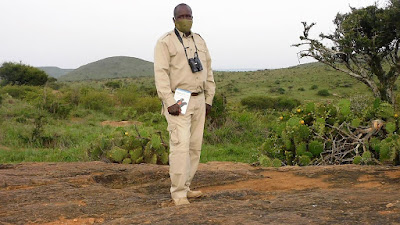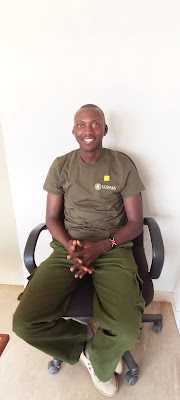Guide Lines
 |
| John Ekaran |
There must be a collective term for Wildlife Guides, those incredibly knowledgeable people who cannot only recognise every feather and whisker of every species, and recall all the facts and figures about them, but also understand their behaviour. Not only that, they have to be diplomats, mechanics, first-aiders, and anthropologists, quick to work out what their clients want to see. Perhaps an ‘encyclopaedia’ of guides, the human equivalents of a search engine – maybe Zoogle.com.
Kenya has a well-recognised system of qualification for wildlife guides and each one will strive to get to the top level. You will never catch one out by asking, “How many eggs does a peacock lay?” because they all know it’s the peahen that lays the eggs!Currently, Elewana Collection employs seven guides at the Loisaba Conservancy, based at one of the three lodges and allocated to individual parties of clients for their entire stay. They compete but also co-operate at finding the most interesting wildlife, always mindful of the need to keep at a responsible distance so as not to affect the life chances of the animals they are watching. The beauty of a private conservancy is that the rules can be easily established and everyone has a vested interest in sticking to them – in this way there is never too much pressure placed on the wildlife, especially the rare wildlife.
John (Scorpio Ekeran) is the Head Guide and has worked for Elewana Collection for around nine years, experiencing different camps such as Joy’s Camp in Shaba National reserve, Elsa’s Kopje in Meru Park, Tortilis Camp in Amboseli, and Sand River in the Masai Mara. At the moment he is based at Loisaba Tented Camp but has also worked from Lodo Springs. It’s a dream job but hard work, rewarded by happy customers and amazing encounters with the wildlife.
“After fifteen minutes, they entered the vehicle itself but fortunately no harm came to my clients who sat very still!”
John is a keen Manchester United supporter and loves to watch wildlife movies in his leisure time – something that he won't get much of at the moment.
Peter (Ekidor) has been at Loisaba for eight years and was actually born here. His father used to make leather covers for the guides’ text books and that ignited Peter’s interest. He is the holder of a Diploma in Tour Guiding and Administration from the Amboseli Institution of Hospitality and Technology, and, like John, he has attained his Silver Level.
Peter takes a special interest in the rarer, endangered animals such as the Grevy’s Zebra, the Reticulated Giraffe and the Gerenuk. He was particularly pleased to see the return of the African Wild Dogs. He is even conscious of the pressures upon the land and the need to protect the whole area from overgrazing:
“Conservation is all about the peaceful co-existence of the communities and people with the wildlife and their understanding of how these animals behave and the space they need.”
Lately Peter has become a photographer in his own right, sharing his special photographs on his Facebook page ‘Naturalist Eki’.
Mohamed (Iribo) expresses great relief about being back at work after the recent lockdown:
“I missed my job, especially the game drives and seeing the animals.”
Again, Mohamed has conservation in his soul – growing up at Ol Pejeta Conservancy where his father was a Game Ranger. As soon as he left school he went to college to study for his guiding qualifications and is qualified at Silver Level.
All of the guides have an empathy as well as an understanding of all the animals – although they are realistic about the cycle of life and death. Mohamed recalls when he was younger seeing an elephant that had died of natural causes and being moved to tears. The other villagers didn’t understand his reaction. Mohamed's regard for the leopards is so well known, that one of Jo's older cubs is named after his daughter, Zakia.
 |
| Peter Ekidor |
 |
| Mohamed Iribo |
“I missed my job, especially the game drives and seeing the animals.”
Again, Mohamed has conservation in his soul – growing up at Ol Pejeta Conservancy where his father was a Game Ranger. As soon as he left school he went to college to study for his guiding qualifications and is qualified at Silver Level.
 |
| Credit: Mohammed Iribo |
More recently he spotted one of the rare black leopards which live on the edges of Loisaba and was transfixed by the sight:
“That was probably my very best moment.”
Hopefully we will soon meet some of the other guides, including Brown, John M, and Boniface with his special interest in elephants. Without the guides, we would all be lost!
The FGASA Silver Level involves a detailed study of seventeen modules followed by an examination:
- Guiding in the natural environment
- Geology
- Weather and climate
- Astronomy
- Ecology
- Biomes
- Taxonomy
- Trees, shrubs, forbs and grasses
- Arthropods - insects and relatives
- Fish
- Amphibians - frogs and toads
- Reptiles
- Birds
- Mammals
- Animal behaviour
- Conservation and habitat management
- Historical human habitation










Comments
Post a Comment